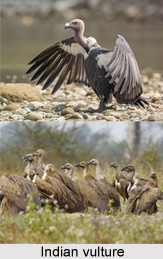 Indian Vulture is an Indian bird with a scientific name "Gyps indicus" is an Old World vulture and is closely related to the griffon vulture, G. fulvus. It breeds mainly on hilly crags in central and peninsular India.
Indian Vulture is an Indian bird with a scientific name "Gyps indicus" is an Old World vulture and is closely related to the griffon vulture, G. fulvus. It breeds mainly on hilly crags in central and peninsular India.
The birds in the northern part of its range once considered a subspecies are now considered a separate species, the slender-billed vulture Gyps tenuirostris. These were lumped together under the name long-billed vulture.
Structure of Indian Vulture
Indian vulture is a long-billed typical vulture, with a bald head, very broad wings and short tail feathers. It is smaller and less heavily built than the Eurasian Griffon, usually weighing between 5.5 and 6.3 kg (12-13.9 lbs) and measuring 80-103 cm (31-41 in) long and 1.96 to 2.38 m (6.4 to 7.8 ft) across the wings. It is distinguished from that species by its less buff body and wing coverts. It also lacks the whitish median covert bar shown by Griffon.
Breeding of Indian Vulture
Indian vulture breeds mainly on cliffs, but is known to use trees to nest in Rajasthan. Like other vultures it is a scavenger, feeding mostly from carcasses of dead animals which it finds by soaring over savannah and around human habitation. They often move in flocks.
Breeding Process of Indian Vulture
The captive-breeding programmes of Indian vulture for several species have been started. Indian vultures are long lived and slow in breeding, so the programmes are expected to take decades. Vultures reach breeding age at about five years old. It is hoped that captive-bred birds will be released to the wild when the environment is clear of diclofenac.











